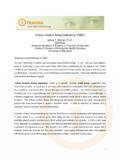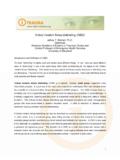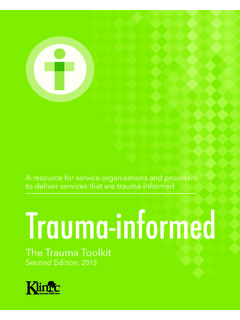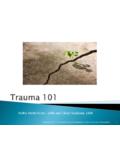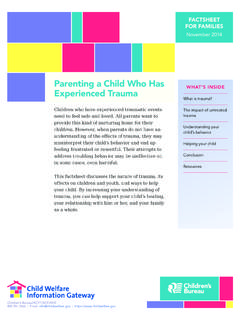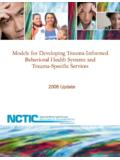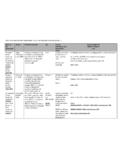Transcription of RAPID DIAGNOSIS TOOLKIT - info-trauma.org
1 RAPID DIAGNOSIS TOOLKIT RAPID DIAGNOSIS OF PTSD In order to present PTSD, your patient must have undergone a traumatic event. The definition of a traumatic event is found in criteria A1 and A2 of the DSM-IV. We shall determine, with the help of the questions that follow, whether or not your patient has been exposed to a traumatic event. 01: Have they ever been subjected to, witness to or been indirectly involved in one or more events that posed a serious physical threat to them or someone else? Yes No (Your patient has not undergone a traumatic event) 02: What type of event was your patient exposed to? If your patient reports more than one such event, consider the one that has the greatest impact on them at the moment. Natural disaster (tornado; hurricane; fire; earthquake; landslide; tidal wave (Tsunami); flood; other).
2 Accident (serious road accident; serious injury or illness; fire; explosion; exposure to a toxic substance; other). Externally (Third party) motivated event (childhood abuse or negligence; physical assault; sexual assault; arson; theft; death threats; hostage-taking; war; torture; other). 03: Which of the following responses best reflect your patient s reaction to the event? He/She felt intense fear. He/She felt totally powerless. He/She were horrified. He/She experienced more than one of these emotions. He/She experienced none of these emotions. (This choice indicates that your patient has not undergone a traumatic event; experiencing at least one of these is required, if the event is to be defined as traumatic .)1 04: How long ago was this event? If the event was repeated or took place over a period of time, reference the moment when it first started.
3 Within the past week. Within the past month. Within the past year. More than a year you have now determined that your patient has been exposed to a traumatic event, you may use the following test to reach a preliminary DIAGNOSIS . In order to refine this DIAGNOSIS we suggest that you practice the correct use of the CAPS via McGill University s website on psychological trauma : self-test, called the Impact of Events Scale - Revised (IES-R) has been validated for use, in both English and French. Compiled are 22 problems that people can experience after a traumatic event. The responses will help us to determine whether or not your patient is suffering from post - traumatic stress FOR WHOM IS THE IES-R SUITABLE? Any adult. WHAT DOES THE IES-R MEASURE? It measures the severity of intrusion, avoidance, and hypervigilance symptoms, experienced over the past LONG DOES IT TAKE?
4 Completion: 5 minutesScoring: 5 minutes SCORING We suggest the following validated method: Tally the responses as follows: Not at all = 0; A little bit = 1; Moderately = 2; Quite a bit = 3; Extremely = 4 When you have calculated the total, refer to the score matrix. INTERPRETATION An IES-R score between 1-11: Your patient presents little or no symptoms of post - traumatic stress . No action is required. An IES-R score between 12-32: Your patient presents several symptoms of post - traumatic stress . Patient monitoring is required. An IES-R score equal to or greater than 33: Most people with this score have post - traumatic stress disorder. Refer the patient (for a more elaborate assessment).3 REFERENCES Weiss, D. (1996). Psychotraumatic review of the Impact of Events Scale Revised. In B. H. Stamm (Ed.). Measurement of stress , trauma and adaptation.
5 Lutherville, MD : Sidan Press. Brunet A., St-Hilaire, A., Jehel, L., & King, S. (2003). Validation of a French version of the Impact of Event Scale-Revised. Canadian Journal of Psychiatry, 48, 56-61. Creamer, M., Bell, R., & Failla, S. (2003). Psychometric properties of the Impact of Event Scale - Revised. Behavior Research & Therapy, 41, 1489-1496. Weiss, D. S. & Marmar, C. R. (1997). The Impact of Event Scale Revised. In J. Wilson & T. Keane (Eds), Assessing psychological trauma and PTSD, 399-411. New York : APPENDICES1. IES-R test 2. Symptoms of post - traumatic stress according to DSM-IV5 IES-R Test (Weiss & Marmar, 1997) Below is a list of difficulties people sometimes have after stressful life events. Please read each item, and then indicate how distressing each difficulty has been for you during the past seven days with respect to the event you experienced.
6 How much were you distressed or bothered by these difficulties? CIRCLE THE NUMBER THAT BEST DESCRIBES THE DIFFICULTIES YOU HAVE HAD. Not at allA little bitMode-ratelyQuite a bitExtre-melyAny reminder brought back feelings about had trouble staying things kept making me think about felt irritable and avoided letting myself get upset when I thought about it or was reminded of thought about it when I didn t mean felt as if it hadn t happened or wasn t stayed away from reminders about of it popped into my was jumpy and easily startled. 01234I tried not to think about was aware that I still had a lot of feelings about it, but I didn t deal with feelings about it were kind of found myself acting or feeling as though I was back at that had trouble falling had waves of strong feelings about tried to remove it from my memory.
7 01234I had trouble concentrating. 01234 Reminders of the event caused physical reactions such as sweating, difficulty in breathing, nausea or palpitations. 01234I had dreams about it. 01234I felt watchful or tried not to talk about Symptoms of PTSD (DSM-IV) According to the diagnostic criteria set by the APA in the DSM-IV, in order to determine if your patient has post - traumatic stress disorder they must satisfy various criteria:A (Exposure to a traumatic event), B (Intrusive symptoms), C (Avoidance and numbing symptoms), D (Symptoms of increased physiological arousal), E (Duration of the disturbance) and F (significant distress or impairment).A: Exposure to a traumatic event The person has been exposed to a traumatic event in which both of the following were present: person experienced, witnessed, or was confronted with an event or events that involved any or all of the following: actual or threatened death; serious injury; or a threat to the physical integrity of self or person's response involved intense fear, helplessness, or : Intrusive symptomsThe traumatic event is persistently re-experienced in one (or more) of the following ways: and intrusive recollections of the event, including: images, thoughts, and/or distressing dreams of the of reliving the event (including hallucinations and flashbacks, experienced while awake or intoxicated).
8 Psychological distress, when exposed to internal or external cues that symbolize or resemble an aspect of the reactivity when exposed to internal or external cues that symbolize or resemble an aspect of the C: Avoidance and numbing symptoms Persistent avoidance of stimuli associated with the trauma and numbing of general responsiveness (not present before the trauma ), as indicated by at least three of the following: 1. Efforts to avoid thoughts, feelings, and/or conversations associated with the trauma . 2. Efforts to avoid activities, places, and/or people that arouse recollections of the trauma . 3. Inability to recall an important aspect of the trauma . 4. Markedly diminished interest or participation in significant activities. 5. Feeling of detachment or estrangement from others.
9 6. Restricted range of emotional Sense of a stunted : Symptoms of increased physiological arousal Persistent symptoms of increased arousal (not present before the trauma ), as indicated by at least two of the following: 1. Difficulty falling or staying asleep. 2. Irritability or outbursts of anger. 3. Difficulty concentrating. 4. Exaggerated startle response. E: Duration of the disturbance(s) (symptoms in Criteria B, C, and D) is longer than one (1) : The disturbance causes clinically significant distress and/or impairment in social, occupational, and/or other important areas of functioning. 8
